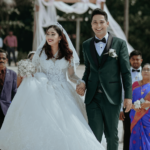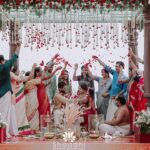With the Muslim religion crossing so many different cultures, countries, and ethnicities, Muslim wedding traditions vary greatly depending on the family traditions of the bride and groom. Before being a part of a Muslim wedding, whether you’re attending as a guest, working as a wedding vendor, or participating as a family member, take a moment to understand the timeline and the nuances of the wedding.
Here are a few things you might see at a Muslim Wedding:
PRE-WEDDING RITUALS:
Valayidal
The typical Kerala Muslim wedding rituals start with the ceremony called “valayidal” function. Valayidal function is done as the groom’s family visits the girl’s house and presents her with a bangle. The valayidal ritual is led by the groom’s mother who gifts her future daughter-in-law with gold bangles and ornaments.
Naal Nischayam
The next step in a traditional Kerala Muslim wedding is when two families come together to fix a wedding date. Usually, this happens in the groom’s house in front of a priest (Maulvi) from the local mosque. After mutual discussion and agreement, they fix an auspicious date for the wedding.
Salatul Ishtikara
This is a pre-wedding ritual in which the Imam performs a prayer to seek Allah’s blessings for the marriage. This ritual is basically an official announcement of the marriage.
Imam Zamin
This follows the SalatulIshtikara. It involves a visit from the groom’s mother to the bride’s home. She brings gifts and sweets and an ominous gold coin, or silver. It is wrapped in a silk scarf and tied around the wrist of the bride, marking her formal welcome and acceptance into the new family.
The Mangni Ceremony:
We all know mangni is the engagement. Close friends and relatives come together to witness the ring exchanging ceremony. Both families shower each other with gifts. This is the public declaration of the betrothal of the bride and groom.
The Manjha Ceremony:
This Muslim wedding ritual is similar to the haldi ceremony. The bride wears yellow and is anointed with turmeric paste that is given by the groom’s family. It is said to bring a natural glow to her skin. After this, a married friend accompanies the bride everywhere until the wedding. It is a celebration with lots of singing and entertainment.
The Mehndi Ceremony:
This Muslim wedding ceremony is done a day or two before the wedding. It is mainly a ladies function where the bride’s hands and feet are adorned with mehndi/henna. Again, a lot of singing and dancing takes place. After this event, she is expected to not leave her house until the wedding.
Sanchaq
The male members of the groom’s family visit the bride’s family with gifts including sweets, a bridal outfit with accessories and jewellery. This is the last pre-wedding ritual, signifying the blessing, affection, and support of the male members of the bride’s new home.
MUSLIM WEDDING RITUALS
Arrival Of The Groom (Baraat) :
The groom goes to the wedding venue on a horse or in a car and his family and friends accompany him throughout the way. The lavish procession consists of dhol beats, music and dancing. The groom and his family come with gifts for the bride. On his arrival, the groom and the brother of the bride share a drink of sherbet (juice).
Nikaah:
This is the primary wedding ritual performed by a Maulvi. The men sit around the groom and the women sit around the bride. The bride’s father is the Waliof the bride. The groom’s family offers her Mehr to seek her consent. Prayers from the Quran are recited by the Maulvi.
The Ijab-e-Qubool is the most pivotal Muslim wedding ritual. The bride and groom are kept separate from each other. The Maulvi asks both of them to consent, and they have to say “QuboolHai” thrice to give their consent. This is similar to the Christian “I do”, only. The bride and groom have to say it thrice and they are behind a hijab that separates them from each other during the process.
This is followed by the NikahNama. This is the official marriage contract where the duties of the groom and the bride, as per the Quran, are recited in presence of two witnesses each from the bride’s and groom’s families. After the official marriage is signed, a Khutba is recited, followed by the marriage vows in the Quran. In the end, the elders perform durud, or blessing on the new bride and groom.
MEHAR is money that the groom’s family is supposed to present the bride with at the wedding day. The amount is decided and mehar is offered.
Once they agree, they are made to sign a document with a set of terms and conditions. After he proposes and she agrees, the groom is taken to the women’s section where he gifts money to the sisters of the bride. Elders then gift the couple and bless them.
Dinner is served separately to men and women. After the lavish first meal, the bride and groom and seated together with a scarf covering their heads and are made to read prayers. The Quran is kept between them and they are only allowed to see each other through mirrors. This is called ARSIMASHAF.
POST – WEDDING RITUALS
Rukhsat:
This Muslim wedding ritual refers to when the bride bids farewell to her family. The father of the bride gives her hand to her husband, asking to protect her always.
Welcoming The Bride:
When the bride arrives at her new home, she is received with a warm welcome by her mother in law. The Holy Quran Is Placed On The Bride’s Head To Symbolise Her Duties As A Wife.
Walima:
This Muslim wedding function is the reception after the wedding that is hosted by the groom’s family. It is a cheerful occasion where friends and family are invited to celebrate the bond among two families.
Chauthi:
On the fourth day from the wedding, the bride and groom visit the bride’s family. The bride’s family greets the groom with a lot of affection and gifts. There is a lavish spread and a lot of gifts for the bride and the groom from the bride’s family. This marks the end of all formal Muslim wedding rituals in between the two families.
These Muslim wedding rituals are so different from the other wedding rituals and traditions we keep hearing about. These are the true Muslim marriage traditions that the bride, the groom, and their families are expected to live by.







